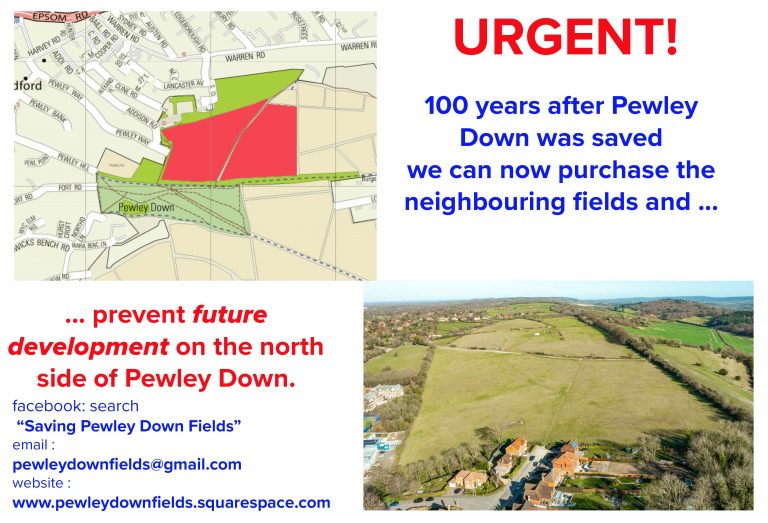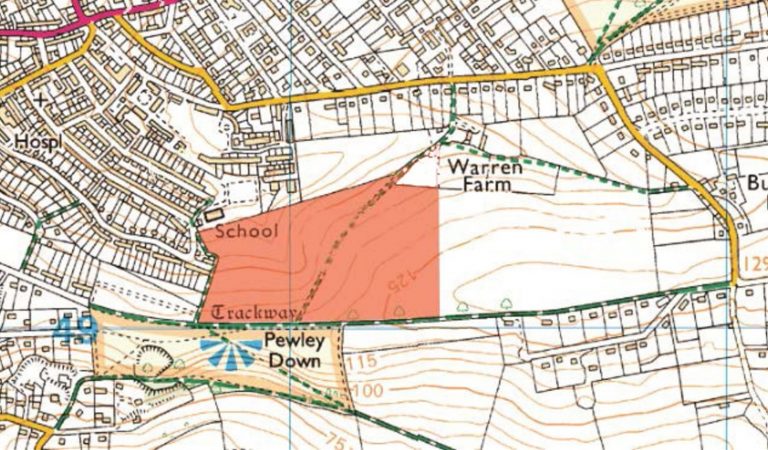The preservation of land at the end of Addison Road and Pewley Way is an amazing story of local action. In April 2021 the field came onto the market and there was interest from a local vineyard and land banks. Locals met on 30th April to discuss giving pledges and the campaign started. The asking price was around £800,000 the campaign was lucky to have the support of a local donor Julia Stephenson whose mother had bought Rosamund Meadows, to save for nature in 1985. The bid process went over £1 million it is understood but the campaign was successful. In fact within 3 weeks the money was raised and on 15th May the Guildford Dragon was able to run a story about the victory. The timing was also appropriate for it was only the previous year that Pewley Down (the other side of the hill celebrated its centenary) – see Guildford Dragon Article

Julia Stephenson, lead donor, said: “I grew up on these beautiful chalk downlands and so I love these meadows as much as the local community. And we shared this same strength of conviction that we knew we just had to do something to protect this wonderful landscape for future generations. To think that we have now achieved that goal feels amazing.”
The meadows, with their spectacular views across the county, are home to nesting skylarks, chalkhill blue butterflies, bumblebees, wild thyme and orchids.

The land is under a 500-year lease to Surrey Wildlife Trust, which also contributed to the purchase. It will be managed by the trust with help from local conservationists and volunteers. A new nature reserve will be created to preserve the land in perpetuity for wildlife and people.
Jonathan Mitchell, one of the campaigners who won the battle for the land, said: “We need to do our utmost to protect such special places for future generations.
‘Since 1945, the UK has lost 97% of its wildflower meadows, so this is a precious opportunity to reduce this loss and restore the rich biodiversity that can thrive on chalk downland.”

The chief executive of Surrey Wildlife Trust, Sarah Jane Chimbwandira, said: “We are extremely grateful to community environmental campaigners in Guildford who have restored a missing piece of the jigsaw puzzle in the landscape for natures recovery.
“Pewley Meadows fills in the gap between Pewley Down Local Nature Reserve and Rosamund Meadows and creates a swathe of 80 acres of precious habitat, which is at the very heart of Surrey’s nature recovery network.”
The head teacher of Holy Trinity Pewley Down School, Clare Brunet, said: “We are over the moon that an area of Pewley Meadows will become an incredibly special new outdoor learning resource for the school.
“The fields can teach us not only about carbon storage, but also about the wildflowers, bees, butterflies and beetles that live there, how to care for them and help their populations expand. I must extend a huge thank you to our wonderful families and the community who have given so generously to enable this to happen.”
One of the lead campangers, David Stokes gave his own verdict on why the campaign succeed
In early May this year, myself and other residents in central Guildford became aware that 37.5 acres of nearby farmland had come onto the market. Chalk downs habitats, and the many species of wildlife that depend on it, are disappearing fast, and although this land was designated as farmland, there had already been attempts to move it out of the protected green belt. Residents formed a group, Saving Pewley Down Fields, to try to buy the land to prevent development. Three weeks later, we had raised over £1 million and we outbid the final competitor, a Land Bank, to buy the land.
HOW DID WE DO IT?
We think our ‘success factors’ included:
- Having a few really committed people whose enthusiasm and positive thinking spread – a multi-skilled group of 12 who formed a steering group to do the work.
- Gaining support of the Surrey Wildlife Trust as a conduit for the money, future leaseholder and manager of the land. Paying money into a recently-formed vehicle, such as a new company, would have been more difficult to set up and sell as a safe place to give money. Dividing the ownership of the land into small blocks of shares asks for problems down the line when beneficiaries with different ideals inherit the shares.
- Having one principle donor, a local conservationist, who underwrote the initial bid.
- Drawing on the wider community including not just neighbours but a School, Residents Association, local Trusts, local Borough Councillors, and even the estate agents (whose business could have been adversely threatened as the residents group made up many of their potential customer-base).
- Asking for ‘significant donations’ (£5k+) only in the first instance and lowering this to £1k as the campaign widened. This sounds a lot of money but, when compared to the effect of a substantial development on property prices, it is not so much. Appeal to resident’s basic instincts first, conservation second.
- Asking for cheques! Yes we used cheques not bitcoin. These are refundable until exchange takes place when they will be cashed. As they are then not refundable, they are eligible for Gift Aid. An escrow account would do a similar job but more complicated and expensive.
- Using social media especially WhatsApp groups and Teams to connect and debate with smaller and larger groups. Explore the Facebook group and continue to follow the story.